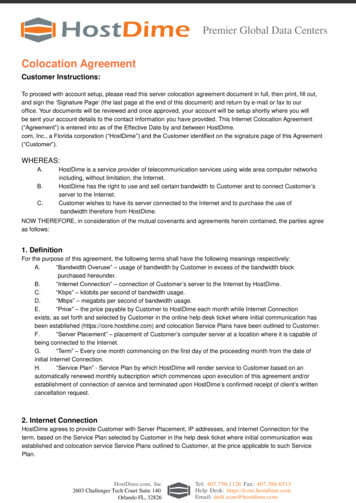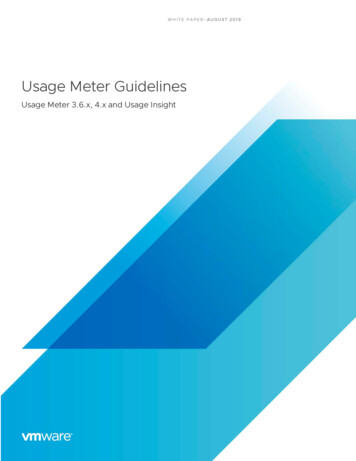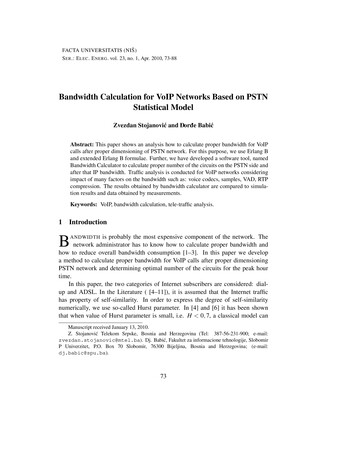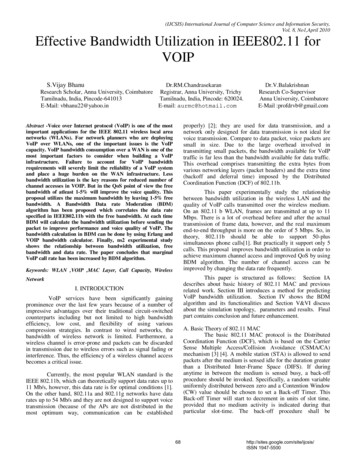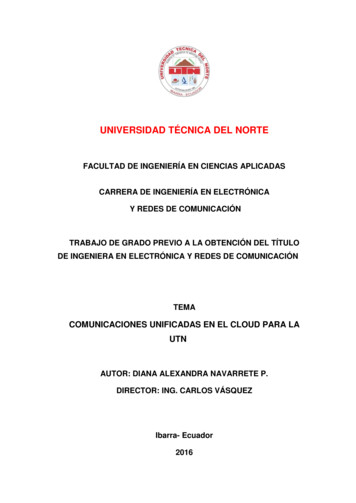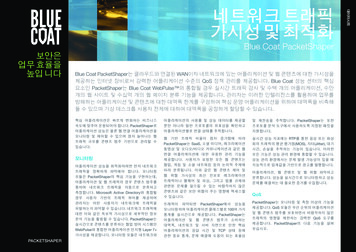
Transcription
Bandwidth usage of common networking applicationsTuesday, September 8, 2009
Overview Bandwidth vs. bandwidth Networking stack review Basic rules for calculating bandwidth usage Examples Calculating bandwidth usage for VOIP Calculating bandwidth usage for an scp session Calculating bandwidth usage for an HTTP download Errors and error correctionTuesday, September 8, 2009
Bandwidth is finite Signal bandwidth is the difference or distance between the high andlow cutoff frequencies in a channel. Like everything else, bandwidth is not infinite. Capacities of common networking media: Ethernet via CAT5e/CAT6 cable - 1 Gbit/sec Ethernet via CAT5 cable - 100Mbit/sec 802.11G wireless 54Gbit/sec T1 data line 1.54 Mbit/sec GSM 64Kbit/sec(voice) 384Kbit/sec(data) These are all theoretical and not achievable in real-world situations.Tuesday, September 8, 2009
What’s eating our lunch ? Overhead is everywhere Structural overhead “The cost of doing business” Physical layer -ethernet frame header, PPP headers, ATM, VSATprotocols Network and transport layer - IP headers Application -Encapsulation and Application-specific headers Errors eat capacity too Retransmission Back-off/sync-ing messages, etc. inefficient recovery interference (wireless)Tuesday, September 8, 2009
Basic bandwidth calculation:TCP/IP over EthernetTuesday, September 8, 2009
Applications: VOIP Bandwidth UsageRoughly, the bandwidth required for a VOIP call isCodec bandwidth (sample frequency/1000)*codec sample rate((Codec bandwidth) ((network overhead) (media overhead)) - VAD** Total Network Bandwidth required*(usually given in Kbits/sec)*Not including add’l Layer 2/3 headers like HDLC, MPLS,etc.**Also called “silence suppression”Tuesday, September 8, 2009
Some common VOIP codecsData Rate(Kbit/sec)Codec Sampleinterval (inmsec)Codecsamplesize(bytes)Voice samplerate(msec)Voicepayload(bytes)payload 3.1 6.33024302434G.723.1 5.33020302034G.729A 81010202050*can also be used at 16 & 24 Kbit/secTuesday, September 8, 2009
G.711 over 802.3 Ethernet Codec characteristics: G.711 - 64Kbit/sec codec 20 msec(160 bytes or 1280 bits) sample payload 50 Payload Packets/Sec(PPS) * 1280 64Kbit/sec Overhead components: Ethernet frame header: 18 bytes (14 bytes 4 byte CRC)*8 144 bits RTP:12 bytes(96 bits) IP header: 20 bytes(160 bits) UDP header: 12 bytes(96 bits)144 96 160 96 496 bits overhead *per packet*50(payload packets/sec)*496 24,800 bits total overhead/sec 64,000 88,800Kbit/sec total bandwidth requiredTuesday, September 8, 2009
In addition Additional Layer2/3 protocols can add an additional 1-4 bytes-perpacket overhead Compression(cRTP, etc.) can remove 40 bytes/packet of overhead Silence Suppresion (VAD) can reduce this even furtherTuesday, September 8, 2009
SSH Protocol Overhead Encrypted protocol with it’s own internal transport, connection andauthentication layers. Adds random(4-255 bytes) of padding to each packets Actual bandwidth consumption depends on channel type, transport,compression, etc. For an ssh “tunnel” the worst-case additional overhead is:4 bytes - ssh packet length1 byte - random padding length(in bytes)1-255 bytes - padding 20 bytes for MAC (depends on MAC algorithm)66 bytes IP encapsulation ----don’t forget this!!346 bytesTuesday, September 8, 2009
Summary When calculating network bandwidth needed for network applications,we must account for overhead used by the various network andtransport layers carrying our data payload Some of this overhead is constant, some is variable. Some of this can’t be fully accounted for(errors, layer 2&3 routingprotocols in intermediate routers, etc.), so we can really only makeclose estimates. The only way to know for sure how much bandwidth an applicationwill use is to to try it out. First get it working, then optimizeTuesday, September 8, 2009
Exercises Calculate bandwidth needed for: G.711 VOIP call over 802.11G Lab Practice use iperf to measure:scp download of a Linux image or other file over Ethernetvs.ftp download of the same file. use tcpdump to look at and identify/compare protocolsTuesday, September 8, 2009
Exercise: G.711 over 802.11G Codec characteristics: G.711 - 64Kbit/sec codec 20 msec(160 bytes or 1280 bits) sample payload 50 Payload Packets/Sec(PPS) * 1280 64Kbit/sec Characteristics for 802.11G 54 Mbit/sec 2.4Ghz wireless protocol Overhead :2 bytes frame-control 2 bytes Duration, 12-24 bytes of address space,2 bytes Sequence Control, 4-bytes CRC Compute estimated bandwidth required Hint: Things might go easier if you convert to bitsTuesday, September 8, 2009
G.711 over 802.11G Codec characteristics: G.711 - 64Kbit/sec codec 20 msec(160 bytes or 1280 bits) sample payload 50 Payload Packets/Sec(PPS) * 1280 64Kbit/sec Overhead components:2-byte frame-control 2-byte Duration 12-24 bytes of address space 2 bytes Sequence Control 4-bytes CRC(trailing)22-34 byte header or 176-272 bits of overhead per packet RTP IP UDP 528-624 bits per packet26400-31200 64000 90.4-95.2Kbit/secTuesday, September 8, 2009
Bandwidth is finite Signal bandwidth is the difference or distance between the high and low cutoff frequencies in a channel. Like everything else, bandwidth is not infinite. Capacities of common networking media: Ethernet via CAT5e/CAT6 cable - 1 Gbit/sec Ethernet via CAT5 cable - 100Mbit/sec 802.11G wireless 54Gbit/sec
